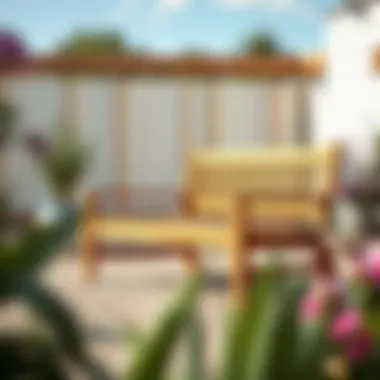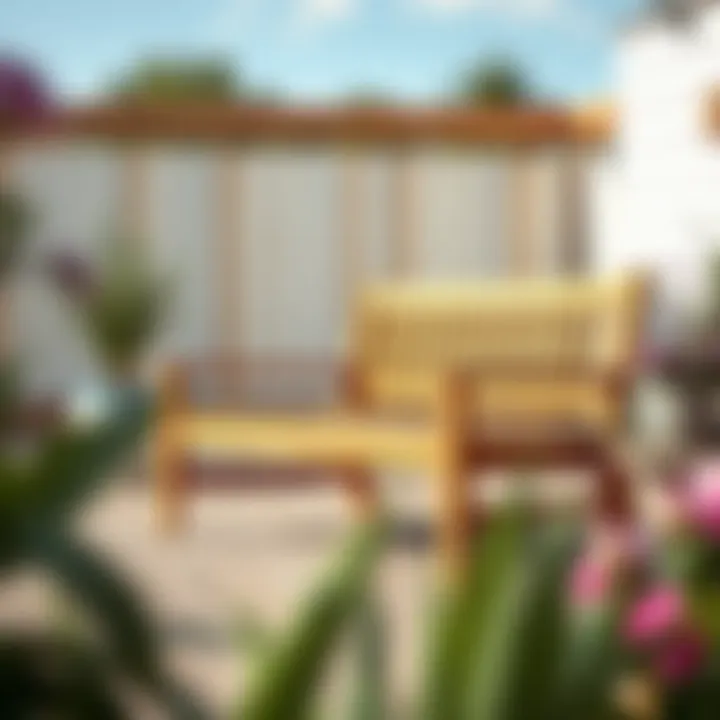Outdoor Decking Benches: Design and Practical Insights


Intro
The outdoor space of a home is often overlooked when it comes to functional furniture. Yet, one piece of design can transform a patio, garden, or deck into a relaxing retreat — the outdoor decking bench. These benches not only add practical seating options but also enhance the aesthetic appeal of your outdoor environments. As more homeowners look to maximize their exterior spaces, understanding the design, functionality, and maintenance of outdoor benches becomes crucial.
When considering outdoor decking benches, it’s essential to understand the main features that merge beauty with utility. Homeowners, designers, and even DIY enthusiasts need to grasp the trends and practical considerations behind these structures to make informed choices that align with their personal taste and the overall decor of the surroundings.
From minimalist styles to rustic charm, outdoor benches offer a multitude of designs to suit any landscape. Whether it's a cozy corner in a lush garden or a modern feature on a sunlit terrace, the right bench can serve as the centerpiece of your outdoor haven. As we dive deeper into the trends and tips, let's illuminate how these benches can be both a functional and stylish addition to your outdoor living experience.
Understanding Outdoor Decking Benches
Understanding outdoor decking benches is crucial for anyone looking to enhance their outdoor spaces. These benches offer more than just a place to sit. They become integral parts of the landscape, providing comfort, functionality, and an aesthetic boost. Before diving into the specifics of design and material choices, it's essential to grasp their definition and purpose, alongside a historical perspective that frames their evolution over time.
Definition and Purpose
Outdoor decking benches are typically constructed from various durable materials suited for outdoor environments. They are designed to withstand the elements while offering a comfortable seating option. Generally found in gardens, patios, and decks, these benches serve multiple purposes beyond mere seating.
- Social Gathering: They create spaces where family and friends can gather, encouraging outdoor socialization.
- Aesthetic Value: With their diverse styles, they enhance the visual appeal of outdoor areas, making the environment more engaging.
- Functionality: Many benches also offer storage solutions, keeping outdoor spaces tidy while maximizing utility.
In a sense, selecting the right outdoor bench is not just about comfort; it's about harmonizing form and function to create an inviting outdoor atmosphere.
Historical Perspective
To appreciate where outdoor decking benches stand today, it's helpful to look back at their history. Traditionally, benches have been utilized for centuries, from ancient civilizations using stone and wood to create seating in public spaces to modern interpretations that incorporate aesthetic design with practical features.
Historically, outdoor seating options were quite basic, primarily serving the need for a resting place in various community gathering areas. The evolution of materials from wood to metal and now composites reflects changes in technology and design tastes. In different cultures, the style has varied significantly:
- In Renaissance gardens, intricately carved wooden benches were a mark of status.
- The industrial age introduced metal benches, which were robust and low-maintenance.
- Today, composite materials allow for customization and sustainability, aligning with contemporary design preferences.
"Each bench tells a story not just of design but of cultural and technological evolution, highlighting our relationship with outdoor spaces."
This historical insight paves the way for understanding the modern enigma of outdoor decking benches, revealing how they blend past traditions with present-day solutions for every homeowner, designer, and DIY enthusiast.
Design Considerations
When we talk about outdoor decking benches, the design considerations are crucial. These choices dictate not only the aesthetic appeal but also the practical functionality of the benches. It’s not just about plopping a bench out on the deck; it’s about integrating a style that complements your space while providing comfort and usability.
A thoughtfully designed bench can transform an ordinary outdoor setting into a cozy haven. Whether it's a serene nook for reading or a social hub for gatherings, design considerations help tailor the benches to specific needs and preferences. Let’s dive deeper into style variations and customization options that enhance these outdoor seating solutions.
Style Variations
Modern
Modern design in outdoor decking benches is all about clean lines and minimalist appeals. This style often features sleek shapes and the use of materials such as metal and composite decking, which lend a contemporary vibe. A standout characteristic of modern benches is their versatility— they can fit seamlessly into any backyard aesthetic, be it chic and sophisticated or relaxed and laid-back.
The unique feature of modern benches is their ability to be both functional and visually striking, often integrating geometric shapes that catch the eye. One advantage is maintenance; modern materials tend to resist wear and tear better than traditional options. However, some might find the starkness of modern styles a bit too cold or impersonal compared to cozier alternatives.
Traditional
Traditional outdoor decking benches, on the other hand, exhibit classic charm that evokes a sense of nostalgia. With rounded edges and intricate details, these benches stand as a testament to craftsmanship. A notable characteristic is their wooden construction, often made from rich hardwoods like oak or teak, which adds warmth to outdoor spaces.
The charm of traditional benches lies in their timeless appeal and the comfort they provide. Their unique feature is the ornamental detailing that tells a story of a bygone era. Nonetheless, they may require more upkeep, as natural wood demands regular maintenance to fend off weather-related damages.
Rustic
Rustic outdoor decking benches offer a connection to nature, often featuring reclaimed wood or distressed finishes. This style brings a sense of warmth and authenticity, making any outdoor space feel inviting. A key characteristic of rustic benches is their organic look, which blends well with natural landscapes and gardens.
The appeal of rustic benches lies in their uniqueness—no two pieces are ever exactly alike, adding character to the décor. They might suit individuals looking for a more grounded aesthetic. However, their ruggedness can also make them less comfortable than more polished contemporary designs, depending on how they are constructed.
Customization and Personalization
Personalization is where outdoor decking benches become an extension of your style. Tailoring options usually boil down to color choices and material selection, which can profoundly impact both the look and feel of your outdoor area.
Color Choices
Selecting the right color for your outdoor bench can either tie the space together or make it pop. Color choices often resonate with personal preferences but also consider the surrounding environment. A vital characteristic of colors in outdoor benches is their ability to absorb or reflect heat, impacting comfort during sunny days.
Bright colors might energize a space, while earthy tones provide a soothing backdrop. The distinctive feature of color customization is that it allows for seasonal changes in decor—people can repaint or accessorize according to seasons, keeping the outdoor area fresh. One downside, though, is that bright colors may fade over time due to sun exposure.
Material Selection
When it comes to material selection, a wide range of options is available, impacting both aesthetics and durability. The key characteristic of various materials, like wood, metal, or composites, dictates how the bench reacts to weather and use. For instance, sturdy metals can withstand harsh conditions better than wood, which may warp over time.
A standout feature in material choice is the variety of textures and finishes available—smooth surfaces create a sleek appearance, while rougher finishes provide a more rustic feel. A substantial advantage is that materials like composite blends often require less maintenance than natural products, but they can sometimes lack the warmth that wood offers.
Material Choices
Choosing the right material for outdoor decking benches is not just about aesthetics. It plays a critical role in functionality, longevity, and maintenance. Different materials come with their own strengths and weaknesses, affecting how well a bench performs over time, how it interacts with the surrounding environment, and how much care it will require. Understanding these materials can assist homeowners, decorators, and DIY enthusiasts in making informed decisions that enhance their outdoor spaces.
Wooden Decking Benches
Types of Wood


When it comes to outdoor benches, the selection of wood is paramount. Teak, cedar, and redwood are some of the top choices due to their natural properties. Teak, for instance, is celebrated for its high oil content, which provides excellent resistance to moisture, insects, and decay. This makes teak a prime candidate for those seeking durability in a humid climate, though it can come with a hefty price tag. On the other hand, cedar presents a more affordable option while still offering natural resistance to pests. However, its softer grain makes it more prone to dents and scratches.
Additionally, pressure-treated lumber is another choice. It’s economical and provides decent longevity, typically lasting several years. However, it requires regular sealing to maintain its condition against the elements. Each wood type brings its unique characteristics that influence not only appearance but also utility in outdoor settings.
Durability and Maintenance
Durability is another cornerstone of material choices. Wooden benches require a level of upkeep that varies widely depending on the type of wood. For instance, teak's natural oils mean less maintenance, needing only an annual cleaning with mild soap. However, untreated softwoods like pine may require staining or sealing every couple of years to maintain their integrity against rot and fading.
In areas with harsh weather, neglecting maintenance can lead to quick deterioration. That's why it’s often said in home improvement circles that a little preventive care goes a long way. Homeowners should weigh their options based on how much effort they want to invest. The initial cost might be attractive, but subsequent maintenance can sometimes hit the wallet hard.
Metal Decking Benches
Aluminum
Aluminum benches are becoming quite popular due to their weight-to-strength ratio. Lightweight, yet sturdy, aluminum doesn’t rust, making it a smart choice for coastal areas where saltwater can hasten decay in other materials. Additionally, aluminum can be molded into various designs, allowing for sleek, modern aesthetics. However, one should be mindful of the potential for scratches and dents, which can affect its appearance over time.
Being an excellent heat conductor, aluminum may not be the most comfortable option when the sun blazes, as it can get quite warm. Thus, it's advisable to use cushions or choose a shaded location for maximum comfort.
Steel
Steel offers unparalleled strength and durability, often seen in urban spaces. Galvanized steel, which is coated to resist corrosion, can stand up to severe weather conditions, providing peace of mind for those who invest in it. Steel benches tend to have a more industrial look, making them suitable for certain modern landscaping choices.
However, one notable downside is the weight; steel can be quite heavy, making it more challenging to move if needed. Just like aluminum, steel can also become hot when exposed to direct sunlight, but the advantages it brings in terms of lifespan and robust construction often outweigh the discomfort when seating.
Composite Materials
Composite materials have gained traction in recent years, combining wood fibers and plastic to form a durable alternative. These benches tend to be resistant to moisture, fading, and insect damage, and they often require minimal maintenance. An eco-conscious homeowner might find composite to be an ideal option as many manufacturers now offer recycled materials in their products.
While composite benches can often resemble wood visually, they can lack the natural appeal and warmth that wood provides. Each composite material will have its unique feel, so understanding the options is important.
In summary, selecting the material for outdoor decking benches extends beyond just the visual. It encompasses practical elements like maintenance, durability, and environmental influences that can shape your outdoor experience for years to come.
Providing homeowners and decorators with a spectrum of choices empowers them to create functional outdoor spaces that resonate with their personal style and practical needs.
Functionality and Utility
When it comes to outdoor decking benches, the terms functionality and utility aren’t just fancy words tossed around for decoration. They are the backbone of why these benches exist in the first place. Every genteel setting beckons for a spot to sit, relax, and enjoy the chaos of nature or maybe just a good book. But beyond comfort, reliance on these benches folds into multiple layers of purpose and design consideration.
Seating Capacity and Comfort
The importance of seating capacity cannot be understated, especially in a gathering environment where families and friends converge. Adequate seating puts a cherry on top of the outdoor experience, transforming any deck into a lively hub. These benches come in various sizes, accommodating anywhere from solitary seating to ample space for several people. The comfort factor plays into this, too—nobody wants to plop down only to feel their tailbone digging into hard wood or metal. Well-designed benches often have ergonomics in mind, curving slightly to support the back and allowing for extended lounging without discomfort. Some even come equipped with plush cushions or lively upholstery options, making them even more inviting.
Integration with Outdoor Spaces
Seamless integration of benches into the landscape transforms a mundane outdoor area into a harmonious retreat. Choosing the right placements can elevate not only the utility of the space but its aesthetic, adding to the overall allure of your backyard.
Placement Strategies
Placement strategies for outdoor benches aren’t just about random positioning. They take into account view, foot traffic, and even the trajectory of sunlight throughout the day. Ideal bench placement allows for conversations that ebb and flow naturally while enabling easy movement around the deck. A key characteristic of this strategy is its focus on accessibility—benches should embrace sun, shade, or even shelter, depending on your climate or preference. This way, they can serve maximum comfort while being visually enticing.
However, there are disadvantages too; inappropriate placement might mean some benches end up overshadowed by larger structures or crowded out by vegetation. An important tip is to envision the flow of human traffic when deciding where to place your outdoor bench.
Complementary Furniture
The role of complementary furniture can’t be ignored. Think side tables, planters, or even deck lounges—these items help tie everything together into an inviting space. The key characteristic of complementary pieces lies in their ability to enhance the functionality of benches while contributing to the overall decor. For instance, small tables set beside your benches create a perfect spot for drinks or snacks, enabling easy access while chatting away with friends.
Still, while it sounds charming to think of everything flowing together, there can be a few bumps in the road. Mismatched styles or colors may distract from the clean look you’re trying to create. Therefore, it’s crucial to strike a balance between the bench design and the additional furnishings, gripping the eye while staying practical.
Outdoor decking benches are far from simple seating solutions. Their functionality and utility ripple outward, offering comfort, style, and thoughtful integration into your space. Consider these aspects deeply, and you'll create not just a seating area, but a sensory experience.
Maintenance and Care
Maintenance and care are paramount when it comes to outdoor decking benches. These pieces of furniture not only serve a practical purpose but also significantly enhance the visual appeal of outdoor spaces. Proper upkeep ensures longevity and keeps the benches looking pristine, providing a comfortable sitting area for years to come. Ignoring maintenance could lead to wear and tear, ultimately affecting both the aesthetic and functional value of the benches.
Benefits of Regular Maintenance:
- Prolongs Lifespan: Regular care can add years to the life of your outdoor benches.
- Sustains Visual Appeal: Keeping benches clean and well-maintained ensures they continue to add charm to your garden, patio, or deck.
- Prevents Damage: Addressing minor issues proactively helps in avoiding costly repairs in the future.
By giving attention to maintenance, homeowners can enjoy the full benefits of their outdoor investments.
Cleaning Recommendations
Cleaning outdoor decking benches isn't just about aesthetics; it's essential for their longevity. Here are some practical recommendations for keeping them in tip-top shape:
- Wash Regularly: Use a mixture of mild soap and water. A soft-bristled brush will help in scrubbing away dirt without scratching the surface.
- Avoid Harsh Chemicals: Strong substances can damage the finish or the material, leading to premature deterioration.
- Rinse Thoroughly: After washing, ensure all soap is washed away to prevent residue buildup, which can attract more dirt.
- Dry Properly: It's best to air dry benches in a shaded area to prevent damaging UV rays from affecting their color and texture.
Maintaining a regular cleaning schedule, especially after heavy use or extreme weather, keeps benches looking fresh and inviting.
Seasonal Maintenance Tasks
As seasons change, so do the needs of outdoor decking benches. Here’s a roadmap for seasonal maintenance tasks to stay ahead of any potential issues:
- **Spring:
- Summer:
- Fall:
- Winter:
- Inspect for Damage:** Check for any cracks, splinters, or loose joints. Repair them before summer.
- Wash the Surface:** A thorough cleaning after winter is essential as debris and grime can accumulate.
- Apply Protectant:** For wooden benches, consider reapplying protective oils or sealants to ward off moisture and UV damage.


- Clear Leaves:** Removing fallen leaves prevents moisture retention, which can lead to mold and mildew.
- Store if Possible:** If feasible, store benches indoors during harsh winter months. If not, cover them with weather-resistant tarps.
By adhering to these seasonal tasks, one can prevent long-term damage, ensuring benches remain a source of joy during all seasons.
Environmental Considerations
In recent years, environmental awareness has become more than just a buzzword—it’s now a foundational principle guiding how we make choices, especially when it comes to our outdoor spaces. The significance of environmental considerations regarding outdoor decking benches cannot be overstated. These benches are not merely functional items; they can impact both the aesthetic of a space and ecological health. The way we select materials, the manufacturing processes, and even the disposal of our benches can have lasting effects on the environment. Here, we explore some key factors and benefits that come into play when integrating outdoor benches into our living environments.
Sustainable Options
When it comes to sustainable options for decking benches, there is a growing market for eco-friendly materials that offer both style and functionality. Homeowners are increasingly choosing recycled or reclaimed wood, which not only helps reduce waste but also provides a unique character to each piece.
- Recycled Materials: Using recycled plastic or composite materials can transform waste into durable, attractive benches.
- Local Sourcing: Selecting materials from local suppliers reduces the carbon footprint.
- Bamboo: Known for its rapid growth, bamboo is a sustainable alternative that is both strong and appealing.
Emphasizing sustainability in the selection process does not just benefit the environment; it can also enhance the aesthetic appeal of outdoor areas. When one chooses sustainable benches, they’re not only making responsible choices but showcasing a commitment to nature.
Impact of Materials on Nature
The impact of materials on nature is a crucial consideration that can guide the decision-making process for both homeowners and designers. Different materials have various eco-footprints and life cycles that affect the world around us. Here are some important points to keep in mind:
- Hardwoods vs. Softwoods: The harvesting of hardwoods like Teak or Mahogany can lead to deforestation if not ethically sourced. Opting for sustainably managed forests ensures that such woods are less harmful.
- Chemicals in Treatment: Many wood products undergo chemical treatments that can leach into the soil and water over time. Choosing benches treated with non-toxic stains or finishes can mitigate these risks.
- Recyclability: The ability of materials to be recycled or composted at the end of their lifecycle matters. Metals, like aluminum and steel, offer a high degree of recyclability compared to certain plastics.
"Considering the impact of materials on nature is not just about preservation, it’s about ensuring a legacy for future generations."
By carefully weighing the implications of material selection, we can make informed decisions that protect our ecosystems without sacrificing quality or aesthetics. This consideration is not just a trend; it's a necessary shift towards sustainability.
Links for further reading:
Market Trends and Innovations
Keeping up with market trends and innovations in outdoor decking benches is vital for both homeowners and designers. Today’s consumers are savvy; they seek more than just a seating option. They want style, durability, and functionality rolled into one. Let's delve deeper into what drives these trends and why it's essential to stay informed.
Emerging Design Trends
The landscape of outdoor furniture design continues to evolve each year, showcasing fresh perspectives and new aesthetics. One of the standout trends is the emphasis on minimalism. Clean lines and simple shapes have taken center stage, making benches appear less cumbersome and more integrated with nature. Such designs often utilize lighter materials, making them easier to reposition or move.
Natural materials like bamboo and reclaimed wood are gaining traction. Homeowners nowadays cultivate a growing awareness towards sustainability, which pushes them to choose eco-friendly options that look good and make them feel good about their choices. Popular colors also lean toward earth tones and soft pastels, offering a calm and inviting atmosphere.
"Staying ahead of these design trends not only enhances outdoor spaces but also reflects personal taste and values."
Additionally, modular designs are emerging. These benches can be rearranged, allowing homeowners to change configurations based on gatherings or personal preference. This flexibility is appealing, especially for those who enjoy entertaining guests.
Technology Integration
Smart Outdoor Furniture
When it comes to smart outdoor furniture, the integration of technology in outdoor benches is becoming a game-changer. Imagine having seating that adjusts based on weather conditions—auto-cooling in the summer and warming in the winter. These features not only increase comfort but also align with modern lifestyles, where convenience is king. A key characteristic of smart outdoor furniture is its connectivity with smartphones. Users can control settings from their devices, making outdoor experiences more interactive and enjoyable.
Yet, as with any innovative technology, there are advantages and disadvantages. The initial investment for smart benches can be higher, though they may save costs in the long run through energy efficiency. Moreover, integration with home automation systems enhances usability but could also lead to potential technical issues down the line.
Multi-functional Designs
Multi-functional designs are another facet of innovation in the outdoor bench market. These benches are not merely places to sit; they often include built-in storage, tables, and even planters. People love the idea of combining functionalities in one piece of furniture, as it helps in maximizing space, especially for those with smaller outdoor set-ups.
One of the appealing aspects of multi-functional benches is their versatility. A bench with storage can keep cushions dry and organized, while those with tables allow for entertaining without needing additional furniture. However, the downside could be that some designs may compromise comfort for functionality, making it essential to choose wisely based on your needs and preferences.
As market trends continue to reshape outdoor living spaces, understanding these innovations can guide decisions that not only maximize comfort and aesthetics but also resonate with modern values of sustainability and efficiency. Keeping an eye on emerging trends ensures that your outdoor area remains functional, stylish, and in tune with contemporary living.
Cost Considerations
Cost considerations play a pivotal role in the decision-making process when it comes to choosing outdoor decking benches. Not only does the budget set the boundaries for material selection and design options, but it also helps homeowners and enthusiasts gauge the overall feasibility of their outdoor projects. Given that outdoor benches can be significant investments, understanding the costs involved ensures that buyers make informed choices that align with both their aesthetic preferences and financial constraints.
Budgeting for Outdoor Benches
When budgeting for outdoor benches, it’s essential to consider several factors that influence pricing. Start by determining how much you’re willing to invest in seating solutions. One straightforward approach is to set a price range, factoring in both the cost of materials and additional expenses such as delivery or assembly.
- Assess your needs: Think about how many people you want to seat and the frequency of use. If the bench will host weekend gatherings, consider durability more than a bench meant for occasional relaxation.
- Explore different options: Search for local providers and compare quotes. You may find that some retailers offer seasonal discounts, which can help keep costs in check.
- Account for additional accessories: Don't forget about extras like cushions or covers, which can enhance comfort and increase longevity.
Factors Affecting Pricing
Material Quality
Material quality significantly shapes the price and longevity of outdoor benches. Choosing high-quality materials can initially cost more but often leads to better durability and lower maintenance costs in the long run. For instance, teak wood, while pricey, is renowned for its incredible weather resistance and beautiful aging process, making it a valuable investment for outdoor decor. The key characteristic of high-quality materials is their resilience against the elements; this reduces the need for frequent replacements, ultimately saving money.
Advantages of superior material quality include:
- Longevity: High-quality benches can last for years, even decades.
- Aesthetics: Premium materials often enhance the overall visual appeal of your outdoor space.
On the downside, these materials can sometimes stretch the budget, so weighing these factors carefully is crucial.


Design Complexity
Design complexity is another consideration that directly impacts pricing. A simple bench with clean lines may cost significantly less than a more intricate design featuring curves or built-in storage. The key element that defines design complexity is craftsmanship; benches that require skilled artisans or advanced techniques generally carry a higher price tag.
Unique features of complex designs include:
- Visual impact: An intricately designed bench can serve as a focal point in your garden or patio.
- Functionality: More complex designs might offer additional benefits like storage solutions or seating for more people.
However, the downside is that these complex options may require additional maintenance or repairs over time, which could add to overall costs.
Ultimately, understanding the various factors affecting costs will better equip potential buyers—be it homeowners or DIY enthusiasts—to make choices that suit both their style and budget.
DIY Outdoor Decking Benches
Creating your own outdoor decking bench can be an invigorating experience. It's not just about having a place to sit; it's about crafting a piece that fits seamlessly into your outdoor space. DIY benches let you channel your creativity and customize your design based on needs and preferences. This section an exploration of basic designs and plans that can set you on the right path, as well as the tools and materials you'll require to bring your vision to life.
Basic Designs and Plans
When considering a DIY project, simplicity often brings the most satisfaction while also being functional. Here are a few key design ideas worth considering:
- Simple Rectangular Bench: A classic choice, this design calls for straightforward construction. Using treated lumber, you can create a long, narrow seat that fits perfectly along a deck or patio. It's easy to scale this kind of bench, whether you want it to accommodate one or two people.
- Corner Bench: If your outdoor area has a nice nook, a corner bench can make it cozier. This design allows you to maximize space while providing a unique seating arrangement. Plans usually involve two back-to-back L-shaped benches, providing ample seating with back support.
- Storage Bench: Combining function with flair often increases utility. A storage bench serves as both a seat and a place to stash gardening tools or cushions. The design can be as elaborate or as straightforward as your inclination allows; just be mindful of the hinges and the internal dimensions.
- Backless Bench: Great for those with limited space, a backless design allows for variability in positioning. These benches can be light and easy to move, perfect for arranging in various spots in your garden or deck.
Detailed plans can be found online; just search for DIY outdoor bench plans for free and rated designs. Choosing a plan that fits your skill level and the tools you have on hand is essential for a successful project.
Tools and Materials Needed
Equipping yourself with the right tools and materials makes all the difference in a DIY project. Here’s a quick rundown of essentials:
- Materials:
- Tools:
- Wood: For most outdoor benches, western red cedar or pressure-treated wood works well. Both offer durability against the elements.
- Screws and Bolts: Outdoor-grade screws will withstand the weather. Galvanized steel is often a preferred choice.
- Wood Adhesive: A quality adhesive can add strength to joints.
- Finish: A weather-resistant stain or sealant helps prolong the life of your bench.
- Saw: A circular saw makes sure you get clean cuts for your pieces.
- Drill: To create pilot holes and insert screws seamlessly.
- Sander: A power sander will offer a smooth finish on rough edges.
- Tape Measure: Precision is key. Measure each split to ensure accuracy in size.
- Clamps: Keeping the wood secure during assembly is very helpful.
Having the right tools at your disposal helps to streamline the process, letting ideas come to fruition. Just remember, safety first. Protect your eyes and hands while working.
Engaging in DIY projects not only enhances your outdoor space but also provides a sense of accomplishment. With the right plans and materials, your custom outdoor bench can turn from concept to reality in no time.
Evaluating Your Options
When diving into the world of outdoor decking benches, evaluating your options is not just a smart move; it’s essential. This stage in the decision-making process can affect everything from comfort and functionality to overall style and durability. Finding the right bench means considering various factors such as material, design, and intended use. To make an informed choice, homeowners, decorators, or DIY enthusiasts must weigh their preferences against practical requirements.
Benefits of Evaluating
- Enhanced Comfort: Understanding your needs helps in selecting a bench that fits your space and use; be it for lounging, dining, or simply enjoying a sunset.
- Longevity: Choosing the right materials can make a world of difference in how long your bench lasts against the elements. You don’t want to be replacing your bench every spring!
- Aesthetic Satisfaction: Your choice should not only provide function but also blend harmoniously with your outdoor decor. It’s crucial to visualize how the bench complements your existing layout.
With so many options available, making a choice without thorough evaluation can lead to buyers' remorse—don’t let hasty decisions derail your outdoor relaxation goals!
Pre-purchase Considerations
Before making that leap to purchase, several key aspects should be on your radar. First off, measure your space. It might sound obvious, but taking accurate measurements ensures that the bench you choose fits snugly in the intended area without crowding the setting.
Consider the following factors:
- Intended Use: Will it be for gatherings, casual sitting, or perhaps kids playing? Each different use case has its own requirements regarding size and sturdiness.
- Climate and Environment: Certain materials withstand weather conditions better than others. For example, if you live near the coast, a marine-grade option may be suitable to resist salt air corrosion.
- Style: Does your garden boast a modern edge, or does it lean towards the rustic? Matching with your home’s exterior enhances the entire aesthetic.
- Budget: Know what you are willing to spend, but also recognize that higher upfront costs may lead to savings in long-term durability and maintenance.
Assessing Quality and Value
Quality should never be an afterthought when evaluating outdoor benches. Look closely at factors like construction, material quality, and brand reputation. While it's easy to be lured in by cheaper options, the saying “you get what you pay for” holds true, especially in furniture designed for outdoor use.
Here are some steps to assess quality effectively:
- Material Inspection: Check the thickness of wood or the grade of metal; sturdier materials typically indicate better construction.
- Joinery Methods: Are the joints glued, screwed, or doweled? Strong joinery will improve resilience.
- Finish Quality: Look for finishes that offer protection against UV rays and moisture, extending the lifespan of the bench.
- User Reviews: Seeking out testimonials can provide insights into user experience. Websites like Reddit often have forums discussing specific brands and their durability—research thoroughly.
Ultimately, investing time in assessing both quality and value ensures that your choice stands the test of time. A bench isn't just a purchase; it’s an investment in outdoor comfort and style.
Epilogue
As we wrap up this journey through the realm of outdoor decking benches, the significance of understanding their various aspects becomes abundantly clear. Outdoor benches are more than mere furniture; they represent a blend of design innovation, practical functionality, and thoughtful integration within outdoor spaces. Selecting the right bench not only enhances the aesthetic appeal of your garden or patio but also fosters a serene atmosphere for relaxation and social interaction.
The benefits of investing in quality outdoor decking benches are plentiful. First, they provide a comfortable sitting area which can serve as a central gathering spot for family and friends. Second, with the right materials and design, these benches can withstand the elements, ensuring a long-lasting addition to any outdoor setting. Specifically, choosing materials such as teak or high-density polyethylene can help resist the ravages of time, making your investment worthwhile.
Additionally, the consideration of customization options allows homeowners to reflect their personal style and complements existing outdoor decor. Custom colors and materials can make a bench not just a functional piece, but a statement in your outdoor design.
Lastly, understanding maintenance needs is crucial. Regular care will prolong the lifespan of your benches, while neglect could lead to rapid deterioration, undermining their beauty and practicality. Thus, regular cleaning, protective treatments, and seasonal checks form an integral part of investing in outdoor furniture, ensuring that your benches remain both functional and visually appealing for years to come.
In essence, whether you're a homeowner seeking to enhance your outdoor area or a designer aiming to provide clients with unique solutions, a well-thought-out selection of outdoor decking benches can significantly elevate the utility and enjoyment of any outdoor space.
Summary of Key Points
- Purpose and Functionality: Outdoor decking benches serve as inviting spaces for relaxation and socializing in outdoor environments.
- Material Selection: Choices range from traditional woods to modern composites, impacting durability, maintenance, and aesthetic appeal.
- Design Considerations: Style variations can complement various outdoor themes, while customization options allow for personal expression.
- Maintenance Insights: Regular upkeep is vital for longevity; adopting a proactive care schedule can prevent rapid wear and extend usability.
Final Thoughts on Selection
When it comes to selecting outdoor decking benches, attention to detail is paramount. Think about your specific needs, and the overall atmosphere you want to create. Is comfort a priority? Consider options with padded seats or ergonomic back support. If aesthetics are more critical, explore unique designs or materials that can serve as focal points in your outdoor space.
Moreover, consider the location of your bench. Positioning it to take advantage of natural surroundings—like a beautiful view or the shade of a tree—can enhance the experience tremendously. Don’t forget to think long-term; selecting high-quality materials will not only provide durability but also ease of maintenance.
In closing, the right outdoor decking bench can transform ordinary spaces into something truly special, inviting homeowners and guests alike to pause, relax, and enjoy the beauty of the outdoors. By weighing the above considerations, you can make an informed decision that aligns perfectly with your design aspirations and lifestyle needs.



